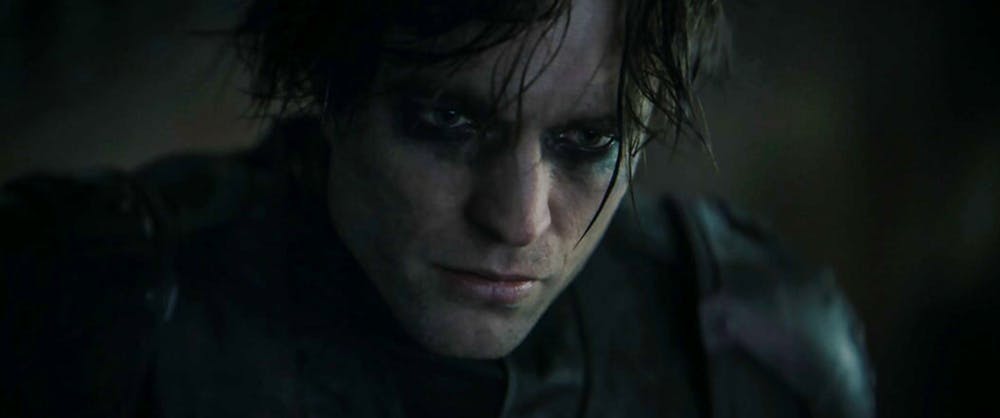Before anyone saw “The Batman,” it already had quite a few targets on its back. For one, the titular character is a beloved icon of American culture. The caped crusader has been appearing in comic book stores since 1939 and on film screens since 1943, garnering a deeply-cherished legacy. On top of that, this is the first solo Batman film since Christopher Nolan’s mid-2000s "Dark Knight" trilogy, easily the pinnacle of superhero filmmaking. The second film in the trilogy, “The Dark Knight,” left little room for improvement in the character’s story. To tie it all together, the new film is a full three hours, a length that seems to be the breaking point for many moviegoers. So the question to be asked is twofold: Is its length justified, and does its creation stand out in an already crowded market of Batman adaptations?
The first question is an easy one to answer: yes. For all its faults to be discussed later, “The Batman” is nothing if not a well-paced, tightly-crafted and action-packed story in which breathtaking cinematography is paired with atmospheric music to completely immerse the viewer. Typically, a movie nearly three hours long that can confidently justify its length is en route to masterpiece status. “The Batman” is much like a hollowed-out redwood tree — from aesthetic principles alone, it is utterly awe-inspiring, but when examined closely, there’s not a whole lot to support it, causing concern that it may topple over at any moment.
The answer to the second question is slightly more complicated. The film clearly sets itself apart from prior Batman films, opting for a detective story plotline as opposed to that of a more general action film. Initially, it seems that this is a good idea considering that the character himself was originally set up as a skilled detective, a fact essentially overlooked in all previous adaptations. But in practice, the execution is a little rocky. The main issue here is that the film is trying to achieve a serious and realistic tone, while using characters and scenarios that are detached from reality and quite absurd. This absurdity can usually be somewhat excused in a standard superhero film because in many instances the film’s lighter tone creates a suspension of disbelief. But since this film is leaving behind that same lighthearted self-awareness, major issues in conventional superhero storytelling are brought to the forefront.
The film, which lands in the crime procedural genre, follows the investigation of a string of murders of corrupt local politicians who are tied to the mob, carried out by a masked figure named the Riddler (Paul Dano). The main investigators of these crimes are Commissioner Gordon (Jeffrey Wright) and Bruce Wayne (Robert Pattinson), better known as the vigilante Batman. This investigation into the identity of the Riddler leads them to a club run by the mob, which was previously involved in a police drug bust. Within the club, more implicated politicians reveal themselves. The mob is led by Carmine Falcone (John Turturro) and the Penguin (Colin Farrell). Circumstances in the club lead to Batman joining forces with waitress Selina Kyle (Zoë Kravitz), also known as Catwoman, whose importance slowly comes to light throughout the film.
The story is plotted in a fairly standard but compelling manner — it purely focuses on Batman and the steps he takes to uncover the nature of the crimes and the Riddler’s identity. This compelling story is undermined by the fact that many characteristics of the film completely conflict with one another. Within the main mob Batman is trying to bust, Carmine Falcone is a calculated, subtle and complex mobster, whereas the Penguin is a character straight out of a slightly culturally insensitive 1980s straight-to-VHS gangster movie. Commissioner Gordon, Batman’s closest ally, is another expertly-acted, complex character. His grounded realism is interrupted by a corrupt, strip club-frequenting police force largely suffering from drug addiction. A series of grim and disturbing murders with deep political undertones are carried out by the Riddler, who has all of the “we live in a society” cringe of Joaquin Phoenix in “Joker” without any of the interesting acting to go along with it.
The film also struggles to find any considerable depth within the two main characters, Batman and Catwoman. Robert Pattinson is a strong Batman, but he’s an even better Bruce Wayne. The film chooses to portray the billionaire not as some philanthropist playboy as he’s been shown in previous films, but rather as a hermit deeply traumatized by his past. When unmasked, Pattinson sheds a whole new light on the character that is easily the most interesting portrayal yet, but we only see him without the mask in about three scenes. Catwoman is also a character whose promising arc ultimately falls flat. A romance forms between her and Batman, but it is so underdeveloped and unbelievable that it should have been left out altogether.
A lot of the fun and intrigue that is shown to be possible in moments of this film ultimately doesn’t reach the heights that it could have. Too often, the film toed the line between creating characters that feel grounded in the real world and characters straight out of a comic book. This leaves a severe conflict of tone that is hard to fully accept. Matt Reeves’ directing should be praised, but his writing should be questioned. At some points the movie is quite good, at others it is quite cringey. In the big picture, it is enjoyable, and in the minutia, a bit of a mess that tries a little too hard.

Finn Kirkpatrick was the senior editor of multimedia of the Brown Daily Herald's 134th editorial board. He is a junior from Los Angeles, California studying Comparative Literature and East Asian Studies. He was previously an arts and culture editor and has a passion for Tetris and Mario Kart.





